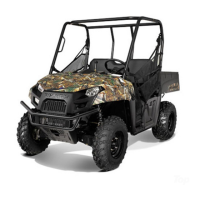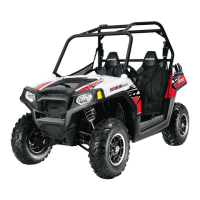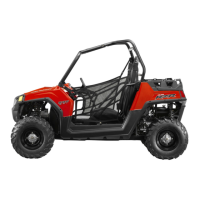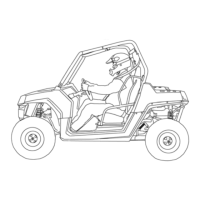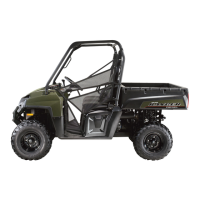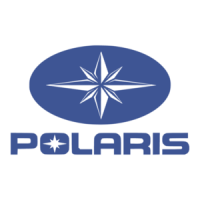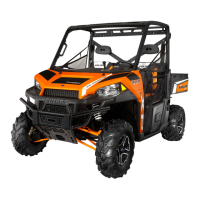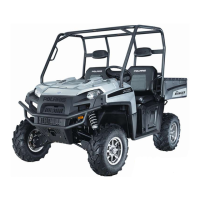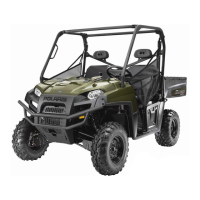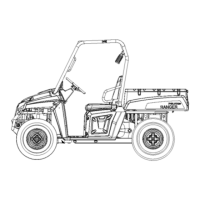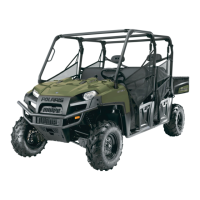
Do you have a question about the Polaris RANGER 800 HD and is the answer not in the manual?
| Brand | Polaris |
|---|---|
| Model | RANGER 800 HD |
| Category | Utility Vehicle |
| Language | English |
Welcomes the owner and outlines the manual's purpose for safe operation.
Explains signal words (WARNING, CAUTION, NOTICE) and safety alert symbols used in the manual.
Covers critical safety rules: adult vehicle only, age limits, no alcohol/drugs, seat belts, cab nets, inspection.
Explains the importance of safety labels and how to obtain replacements.
Lists key "Never Operate" and "Always" safety guidelines for safe vehicle operation.
Covers Age Restrictions, Alcohol/Drugs, Instruction, Seat Belts, Cab Nets.
Covers Inspection, Gasoline Handling, Exhaust Exposure, Damaged Vehicles.
Covers Speed, Pavement, Public Roads, Turning, Jumps, Terrain, Slippery Surfaces.
Identifies major exterior and interior vehicle components.
Explains console layout, including Park Brake, Gear Selector, Instruments, Mode Button, and Outlets.
Describes Ignition, Lights, AWD/Differential Lock switches.
Covers Brake/Throttle Pedals, Hitch Bracket, and Adjustable Steering Wheel.
How to properly secure and open the vehicle's cab nets for safety.
Proper use of seat belts for 3-point and lap belts, emphasizing safety.
Describes the speedometer, indicator lamps, and rider information center.
Explains Odometer, Trip Meter, Hour Meter, Tachometer, and Clock modes.
Covers Programmable Service Interval and Diagnostic Display Mode for EFI faults.
Essential steps for breaking in the engine, drivetrain, and PVT system.
Importance of pre-ride checks and a list of inspection items.
Procedures for starting, stopping the engine, and operating the brakes.
Step-by-step guide for operating the vehicle safely.
Precautions and techniques for driving on slippery terrain.
Safe practices for driving over obstacles, uphill, and downhill.
Rules for safe cargo hauling, including speed and load limits.
Guidelines for towing loads, including capacity, speed, and safety.
How to engage/disengage AWD and lock the differential for traction.
Covers Noise, Public Lands Operation, Crankcase, Exhaust, and EMI compliance.
Comprehensive chart detailing maintenance intervals and tasks.
Specific lubricant recommendations for various vehicle components.
Covers oil recommendations, checking, and changing the oil and filter.
Details lubricant specs and maintenance for Front, Middle, and Rear gearcases.
Procedures for checking and changing transmission oil for 4x4/Crew models.
Covers spark plug selection, inspection, and torque specifications.
Covers coolant levels, adding/changing coolant, and radiator/fan care.
Procedures for checking radiator coolant and cleaning the power steering unit.
Procedures for maintaining the air filter and replacing the fuel filter.
Safety warnings and procedure for purging the spark arrestor.
Covers throttle freeplay inspection, adjustment, and throttle body idle RPM.
Covers brake fluid level, inspection, and park brake checks.
How to adjust suspension stiffness and spring tension.
Covers tire tread depth, wheel nut torque, removal, and installation.
Covers headlight replacement, brake light check, and headlight beam adjustment.
Information on fuse functions and procedures for replacing blown fuses.
Covers electrolyte safety, cleaning, fluid levels, removal, and installation.
Guidelines for storing and charging conventional and sealed batteries.
Recommended procedures for washing, polishing, and storing the vehicle.
General storage advice including fluid levels, engine fogging, and area preparation.
Steps to prepare the vehicle after storage.
Procedures for safely securing and transporting the vehicle.
Technical data for the RANGER 4X4 model.
Technical data for the RANGER 6X6 model.
Technical data for the RANGER CREW model.
List of part numbers for various lubricants, coolants, and accessories.
Troubleshooting causes and solutions for drive belt wear and burning.
Troubleshooting for engine start failures, backfires, and park brake engagement issues.
Troubleshooting for engine pings, knocks, stalls, misfires, and fuel mixture problems.
Troubleshooting for when the engine stops or loses power.
Details the limited warranty, its duration, and the registration process.
Covers warranty exclusions, remedies, and California resident notes.
Information on obtaining warranty service and coverage for specific parts like spark arrestors.
Policies for exported vehicles and obtaining service abroad.
Warranty considerations for private purchases and customer support contacts.
Covers emissions warranty duration, covered components, and related systems.
Outlines remedies, exclusions, owner maintenance duties, and emission control servicing.
Instructions for using the log to record vehicle maintenance history.
